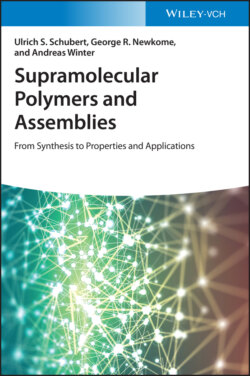Читать книгу Supramolecular Polymers and Assemblies - Andreas Winter - Страница 13
1.2 Classification Schemes
ОглавлениеAccording to Meijer and coworkers, three main different aspects have to be considered when classifying supramolecular polymers [27]: first, the physical nature of the non‐covalent interaction (i.e. the origin/type of the reversible interaction, “physical origin classification”), the type of molecular component or monomers utilized (“structural monomer classification”), and, finally, the Gibbs free energy of the polymer expressed as a function of the monomer conversion (“thermodynamic classification”). It has been under discussion if even a fourth classification scheme can be applied taking into account the dimensionality of the resultant assembly. However, it needs to be emphasized that the addition of a second (or even third) dimension is expected to introduce additional interaction energies which, in turn, will have a considerable influence on the Gibbs free energy (ΔG0) of the supramolecular materials [26]. Thus, the understanding of how changes in certain parameters, such as concentration and/or temperature, impact the 3D structure of the material is no longer straightforward.
However, supramolecular polymers are typically classified according to the nature of the non‐covalent interaction(s) on whose basis they have been assembled from, thus taking into account the main chemical driving force for the formation of large assemblies [26]; several reviews have dealt with these types of materials [29–37]. Non‐covalent interactions are intrinsically much weaker (i.e. ranging from c. 1 to 120 kJ mol−1), in particular when compared to the strong covalent bonds (150–1000 kJ mol−1). Table 1.1 summarizes the strength of the different interactions, ranging from rather weak (van der Waals and charge–transfer) through medium (H‐bonding, hydrophobic–hydrophilic, and ion‐pairing interactions) to strong (metal‐to‐ligand coordination). Accordingly, one can correlate the strength of the supramolecular interaction(s) to the virtual molar mass and, thereby, to the degree of polymerization (DP, vide infra).
Table 1.1 The strength and directionality of non‐covalent interactions.
Source: Friese and Kurth [38]. © 2009 Elsevier.
| Type of non‐covalent interaction | Strength (kJ mol−1) | Directionality |
|---|---|---|
| van der Waals interactions | 1–5 | Low |
| Charge–transfer interactions | 7–20 | Medium |
| Hydrogen‐bonding interactions | 10–20 | High |
| Hydrophobic–hydrophilic interaction | 12–15 | Low |
| Ion‐pairing interactions | 12–20 | Medium |
| Metal‐to‐ligand coordination | 40–120 | High |
| Covalent bond | 150–1000 | High |
As a result, from their comparably low strength and non‐covalent character, most of these interactions feature a certain degree of reversibility. In other words, the monomeric units of a supramolecular polymer can readily be assembled and disassembled resulting in new, interesting properties and potential applications that are not (or only hardly) accessible for covalent polymers. Utilizing all of these different types of non‐covalent interactions allows one to assemble “tailor‐made” supramolecular polymers, which reveal the key property, i.e. reversibility of binding [29].
Moreover, with respect to the synthesis of any type of supramolecular polymer, the directionality of the utilized non‐covalent bond is of utmost relevance. In classical polymers, the covalent bonds with their perfect directionality represent the linkage of two monomeric units. On the contrary, supramolecular polymers often rely on interactions, which feature a much lower degree of directionality (e.g. ion‐pairing or charge–transfer interactions). Only hydrogen‐bonding interactions, certain types of metal‐to‐ligand coordination, and host–guest inclusion complexes offer very high directionalities, which are comparable to those of conventional covalent bonds. In summary, the directionality and strength of the non‐covalent interactions represent crucial parameters when dealing with (linear) supramolecular polymers.
Taking the aforementioned “structural monomer classification” scheme, one can distinguish between two cases: first, a single molecular component is equipped with supramolecular binding site of either a self‐complementary or a complementary nature. For instance, the reversible association into an A2‐system in solution is based on the self‐complementary A:A interactions (accordingly, an A–B‐type system is formed by reversible complementary A:B interactions). Second, the two different homoditopic monomers A–A and B–B may exhibit only one type of interaction; in this case, the supramolecular polymerization process is driven solely by the complementary interactions between A and B.
Finally, the classification of supramolecular polymerizations according to their thermodynamics has to be considered: for supramolecular polymers, ΔG0 can be expressed as a function of the monomer conversion from zero (p = 0) to full conversion (p = 1). Here, the particular mechanism by which a supramolecular polymer is formed from monomeric components has to be considered (this process is dependent on various parameters, e.g. concentration, solvent, and temperature).
